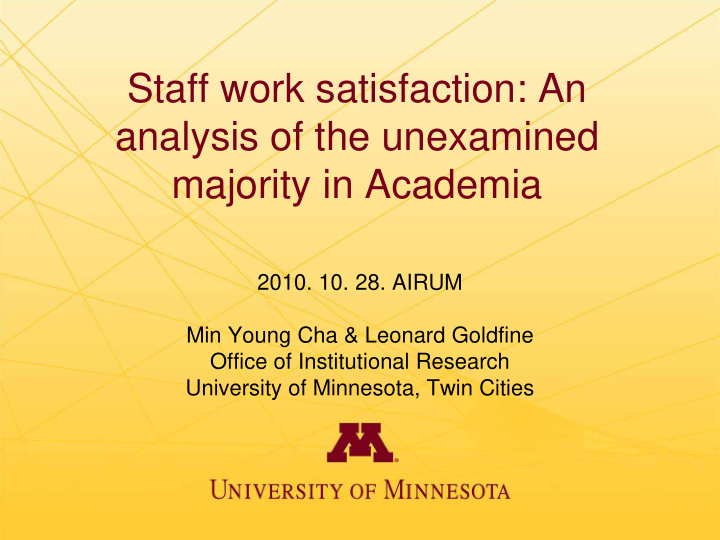



Staff work satisfaction: An analysis of the unexamined majority in Academia 2010. 10. 28. AIRUM Min Young Cha & Leonard Goldfine Office of Institutional Research University of Minnesota, Twin Cities
Presentation outline • Introduction • Literature review • Method • Result • Implications • Future research • Contact information
Introduction: why staff satisfaction matters? • Majority of university employee population • Indicator of organizational productivity • Increasing professionalization
Majority of university employees • Approximately 4/5 of total employee population Employee distribution Non-faculty employee distribution FA Non-faculty employee 5.4% 15.0% 20.5% 33.3% 14.8% 79.5% 31.5% AA AP BU CS IPA AA: Academic Administrator AP: Academic Professional BU: Bargaining Unit CS: Civil Service IPA: Instructional Professional and Administrator
Employee satisfaction and organizational productivity • Campbell (1977): Organizational Effectiveness category • Mayo (1933): - Job satisfaction, productivity, Human Relations theory motivation, growth, quality, - Satisfied workers turnover, morale, internalization are productive. of organizational goals, etc.
Increasing professionalization
Literature review Work satisfaction from classics • Herzberg (1966): • Maslow (1959): Hierarchy of Needs The Motivation-Hygiene theory
Pulse survey background • Biennial survey since 2004 (4 th iteration in 2010) • Total response rate: 45.6 % (8,539 completed out of 18,717) • A single online questionnaire for all university employees • System-wide staff response rate: 47.3% in 2010 • System-wide faculty response rate: 39.3% in 2010
Response rate by job category & gender 70 66.7% staff average 47.3% 59.0% 60 AA 64.4% 50 41.0% AP 45.8% 40 33.3% 30 BU 36.1% 20 CS 54.6% 10 IPA 24.2% 0 0 10 20 30 40 50 60 70 responded F responded M Female Male AA: Academic Administrator AP: Academic Professional BU: Bargaining Unit CS: Civil Service IPA: Instructional Professional and Administrator
Response rate by gender in job groups Academic Academic Administrator Professional 66.7% 64.4% 57.6% 50.3% 49.7% 42.4% 38.0% 35.6% Instructional Professional & responded responded Female Male responded F responded Female Male Administrator F M M 62.1% 54.2% 45.8% 37.9% Civil Service Bargaining Unit 66.3% 61.8% 75.1% responded F responded M Female Male 59.6% 38.2% 33.7% 40.4 24.9% responded responded Female Male responded F responded M Female Male F M
Method • Exploratory study • Step wise linear regression • Variables
Result
Implications • Different job characteristics require that differentiated attention be paid to HR policies. (e.g. AP: support for innovative work IPA: support for high quality work) • Gender: not as significant as other work-related factors in all groups but AA • Age : not as significant as other work-related factors in AP and IPA
Future study • 2nd stage studies on satisfaction of employees by each job category & campus • Focus group interviews for insider’s voice & suggestions • Consideration of measuring organizational intervention (e.g. decision making process) • Consideration of response rate by job group • Consideration of graduate teaching assistants’ work
Contact information Leonard Goldfine Min Young Cha Assistant Director Graduate Research Assistant Office of Institutional Research Office of Institutional Research University of Minnesota –Twin Cities University of Minnesota –Twin Cities 272-2 McNamara Alumni Center 272-B McNamara Alumni Center 200 Oak St. SE 200 Oak St. SE Minneapolis, MN 55455 Minneapolis, MN 55455 612-624-0008 612-625-1481 chaxx062@umn.edu gold0154@umn.edu
Recommend
More recommend